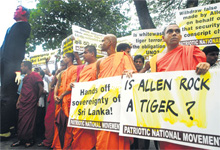 Demonstration in Colombo, November, 2006
Demonstration in Colombo, November, 2006
SANGAM.ORG
Ilankai Tamil Sangam, USA, Inc.
Association of Tamils of Sri Lanka in the USA
by P.S., November 22, 2006
|
The international community can only hear the ‘violence’ of the Tamil Tigers, but they cannot see how the Tamils have been harmed for 58 years by successive Sri Lankan governments. |
Rt Hon Sir:
Someone outside a house might hear the screaming of a child from inside a house, but would not be able to see how the child is being harmed by an adult. The international community can only hear the ‘violence’ of the Tamil Tigers, but they cannot see how the Tamils have been harmed for 58 years by successive Sri Lankan governments.
|
Thus, it is little wonder that you have said: "I'd just say on behalf of the United States that we have faith in the government and faith in the President of Sri Lanka. They do want to make peace," "We also believe that the Tamil Tigers, the LTTE, is a terrorist group responsible for massive bloodshed in the country and we hold the Tamil Tigers responsible for much of what has gone wrong in the country.” and "We support the government. We have a good relationship with the government.”
I appeal to the Under Secretary to read at least the following ( preferably in addition to the contents of the US State Department's human rights country reports on Sri Lanka and reports of the last 25 years by Amnesty International, the International Commission of Jurists, UNCHR, etc.) before you make your judgment:
http://www.columbia.edu/~as48/Sri Lanka and the Tamils.pdf
Chapter 4 How Nation State “Grammar” Helped Construct Polar and Conflictual Identities: Sri Lanka and the Tamils (Aug 2006)
…………….
There were major Sinhalese/ Tamil riots in1958, 1977, 1981, and 1983 and that since 1983 Sri Lanka has been in the grip of a brutal war of secession over the independence of the Tamils, and that the quality of democracy, once seen as one of the best in Asia, has deteriorated, indeed, at times, almost broken down. Indeed, according to one of the standard compilations of deaths by political violence, it appears in our judgment, that for the 1946-2004 period, the Tamil / Singhalese civil war in Sri Lanka, has contributed to the highest per capita death rate, among democracies or near democracies, in the world.
………………
What explains the outbreak of unprecedented Sinhalese violence a decade after independence?
……………………
At independence there were no significant political leaders in the territory of the new state who were seeking independence from Ceylon. As late as 1970 there were no Tamil guerrillas yet in the jungle. The strongest Tamil voice for greater territorial autonomy was that of the democratically elected members in parliament of the Federal Party. However, their 1970 general election manifesto still categorically stated: “It is our firm conviction that the division of the country in any form would be beneficial neither to the country nor to the Tamil-speaking people. Hence we appeal to the Tamil-speaking people not to lend their support to any political movement that advocates the bifurcation of the country’’. ………………………….
Ceylon after independence, probably could have remained a peaceful unitary state as long as no aggressive nation state policies were followed that reduced the quality and participation of Tamils in the political system a combination of some, not too aggressive, nation state policies, mixed with some state nation policies, would probably have maintained social peace and a well functioning democracy. what actually happened in Ceylon, particularly from 1956 to 1983, was that very aggressive nation state policies ended up not only not fostering a unified nation state in Ceylon, and certainly not a state nation, but in constructing two warring aspirant nation states in one state.12 Aggressive nation state building policies in Sri Lanka put the multinational society on the “slippery slope” of state erosion and democratic decay.Certain nation policy decisions, or outbidding by Sihala politicians to their Sinhala/Buddhist constituencies led to sequences of events that reduced Tamil participation in, and loyalty to, Sri Lanka.
The disenfranchisement of “Indian Tamils” in 1948-9, the 1956 electoral campaign that lead to the increasing Sinhalization of the state, communal violence and abandonment of neutrality by the security apparatus, and the loyalty oath of 1983 that fatally shifted the major center of Tamil political power away from politicians in Parliament, to guerrillas in the jungle.
……………………….…………………………….
A large number of International Human Rights bodies have written reports from 1977 onwards on the injustice to - and annihilation of - Tamils by successive Sri Lankan governments.
I am very sad to note that you said “We are not neutral in this respect," in your address to the press after yesterday’s Co-Chair's Conference.
Yours sincerely,
[Name redacted]
© 1996-2025 Ilankai Tamil Sangam, USA, Inc.